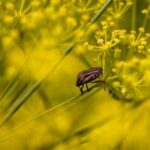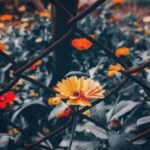Are you looking to create a beautiful and inviting butterfly garden in the sunny state of Florida? Designing a Florida butterfly garden layout requires careful consideration of the state’s unique climate and environment to attract these delicate creatures.
In this article, we will explore the key elements of creating a stunning butterfly garden in Florida, with a focus on the design layout. From choosing the right location to selecting butterfly-friendly plants, we’ll cover everything you need to know to bring these colorful insects into your outdoor space.
Florida is home to a rich diversity of butterfly species, making it an ideal location for creating a butterfly garden. With the right design layout, you can create a haven for these enchanting creatures while enhancing the beauty of your outdoor space. By incorporating the right elements into your garden, such as native plants and habitat features, you can attract and support butterflies throughout their life cycle.
In this article, we will guide you through the process of designing and maintaining a Florida butterfly garden that will not only be visually stunning but also provide essential resources for these winged wonders. Whether you’re new to gardening or have experience with landscape design, our tips and suggestions will help you create a thriving butterfly habitat that brings joy and wonder to your outdoor environment.
Choosing the Right Location for Your Butterfly Garden in Florida
Understanding Sunlight Requirements
When choosing a location for your Florida butterfly garden, it’s important to understand the sunlight requirements of both the butterflies and the plants you’ll be including in your garden. Most butterfly species prefer open areas with plenty of sunshine. Look for a spot in your yard that receives at least 6 hours of direct sunlight each day.
Avoiding Pesticides
Another consideration when choosing a location for your butterfly garden is to avoid areas where pesticides may be present. Pesticides can be harmful or fatal to butterflies, so it’s best to steer clear of locations where these chemicals are used regularly, such as near agricultural fields or heavily landscaped areas.
By carefully selecting the right location for your Florida butterfly garden, you can create an ideal habitat that attracts these beautiful creatures while also providing them with the necessary conditions for feeding and reproduction. With proper planning and consideration of sunlight and pesticide exposure, you can ensure that your butterfly garden will flourish and become a haven for these delicate insects.
Selecting Butterfly-Friendly Plants for Your Florida Garden
When it comes to creating a butterfly garden in Florida, selecting the right plants is essential to attract and support these beautiful creatures. Butterflies are attracted to a variety of nectar-producing flowers, so it’s important to choose plants that will provide a continuous source of nectar throughout the year. Additionally, including host plants for caterpillars is crucial as they serve as food sources for developing butterflies.
Native Plants
One key factor in selecting plants for your Florida butterfly garden is choosing native species. Native plants have evolved with the local ecosystem and are well-suited to the climate and soil conditions of the region. They also provide vital resources for native butterflies and caterpillars, making them an essential component of any butterfly garden.
Nectar-Producing Plants
When choosing plants for your garden, be sure to select a variety of nectar-producing flowers that will bloom at different times throughout the year. This will ensure that there is always a food source available for butterflies. Some popular options for Florida butterfly gardens include milkweed, pentas, salvias, and coneflowers.
Host Plants
In addition to nectar-producing flowers, incorporating host plants for caterpillars is crucial for supporting the complete lifecycle of butterflies. Different butterfly species have specific host plant preferences, so it’s beneficial to include a variety of options in your garden. For example, milkweed is a host plant for monarch butterflies, while passionflower serves as a host plant for Gulf fritillary butterflies.
By carefully selecting a diverse range of native plants that offer both nectar and act as hosts for caterpillars, you can create a thriving habitat that attracts and supports a wide array of butterfly species in your Florida garden.
Designing a Water Feature for Your Florida Butterfly Garden
When creating a butterfly garden in Florida, incorporating a water feature is essential to attract and support the local butterfly population. Butterflies are drawn to shallow water sources for drinking and depositing eggs, making a well-designed water feature a key element of your garden.
Consider the following when designing a water feature for your Florida butterfly garden:
– **Size and Type**: Choose a water feature that is shallow and has sloping sides to allow butterflies easy access. A small pond, birdbath, or even a simple shallow dish can serve as an effective water source.
– **Placement**: Position the water feature in an open area of your garden where it can receive plenty of sunlight. Ensure that it is sheltered from strong winds to prevent excessive evaporation.
– **Maintenance**: Regularly clean and refill the water feature to provide a clean and reliable source of water for visiting butterflies. Adding some rounded stones or gravel to the bottom of the feature can also provide landing spots for butterflies while preventing mosquito larvae from breeding in the water.
By incorporating a well-designed water feature into your Florida butterfly garden, you can create an inviting habitat that supports the needs of local butterfly species while adding visual appeal to your outdoor space.
Overall, designing a water feature properly will not only attract butterflies but also contribute to the overall health and success of your beautiful Florida butterfly garden.
Understanding the Importance of Sunlight and Shade in Your Garden Layout
Sunlight and shade are crucial factors to consider when designing the layout of a butterfly garden in Florida. The Sunshine State experiences hot and humid weather for most of the year, making it essential to provide both sunny and shaded areas for the butterflies in your garden. When planning your garden layout, it is important to understand how sunlight and shade can impact the growth of plants, as well as the behavior and well-being of butterflies.
In Florida, the ideal location for a butterfly garden should receive at least six hours of direct sunlight each day. This will ensure that the nectar-rich flowers that attract butterflies have enough sunlight to thrive. However, providing some shaded areas within your garden is equally important.
Shaded spots can offer protection from extreme heat and allow butterflies to rest and cool off during the hottest parts of the day. Incorporating trees, shrubs, or trellises can create shaded areas that provide relief from the intense Florida sun while still allowing for sufficient sunlight penetration.
When considering plant placement in your Florida butterfly garden, keep in mind which plants prefer full sun, partial sun, or shade. For example, milkweed – an essential plant for monarch butterflies – thrives in full sun but can also tolerate partial shade.
On the other hand, pentas and salvias are nectar-rich flowers favored by many butterfly species but require full sun to bloom abundantly. By carefully selecting and arranging plants based on their sunlight needs, you can create a well-balanced garden layout that caters to both plants and butterflies.
| Benefit | Consideration |
|---|---|
| Impact on plant growth | Sunlight provides energy through photosynthesis; proper shade prevents wilting and heat stress. |
| Behavior of butterflies | Sunlight provides warmth for activity; shaded areas serve as resting spots. |
| Plant selection | Selecting plants based on their sunlight preferences is crucial for overall garden success. |
Attracting Butterflies to Your Florida Garden With Habitat Features
If you want to attract butterflies to your Florida garden, it’s essential to create a habitat that is inviting and conducive to their needs. By incorporating specific features into your garden design, you can provide an environment that will attract and support these beautiful insects. Here are some habitat features to consider:
1. Host Plants: Incorporating host plants into your garden is crucial for attracting butterflies. These are plants that caterpillars feed on and rely on for survival. In Florida, some popular host plants include milkweed for monarch butterflies, passionflower for gulf fritillary butterflies, and parsley for black swallowtail butterflies.
2. Nectar Plants: Butterflies also need a source of nectar for feeding. By including nectar-producing plants in your garden, you can provide the sustenance that butterflies need to thrive. Some butterfly-friendly nectar plants for Florida gardens include pentas, lantana, salvias, and coneflowers.
3. Sheltered Areas: To make your garden more appealing to butterflies, be sure to include sheltered areas where they can seek refuge from predators and inclement weather. This can be achieved by planting dense shrubs or providing features such as trellises or small structures that offer protection.
Incorporating these habitat features into your Florida butterfly garden will not only attract butterflies but also provide them with the resources they need to thrive and contribute to the overall beauty of your garden. By creating an ideal habitat, you can enjoy the presence of these enchanting creatures while supporting their continued existence in the region.
Maintaining Your Florida Butterfly Garden for Long-Term Success
Once your Florida butterfly garden is established, it is important to maintain it properly to ensure long-term success. Regular maintenance will help keep the garden healthy and attractive for butterflies. One essential aspect of maintaining a butterfly garden in Florida is weed control. Weeds can compete with butterfly-friendly plants for resources, so regular weeding is necessary to keep them at bay.
In addition to weed control, it’s crucial to monitor and manage pests in your butterfly garden. Some pests can damage butterfly-friendly plants and disrupt the ecosystem you’ve created. Integrated pest management techniques, such as using beneficial insects or organic pesticides, can help keep pest populations in check without harming butterflies or other beneficial insects.
Regular watering is also essential for maintaining a healthy Florida butterfly garden. Installing a drip irrigation system or soaker hoses can help deliver water directly to the roots of plants without wasting water through evaporation or runoff. Proper watering will help your garden thrive while conserving water, which is especially important in a state like Florida that often experiences drought conditions.
| Aspect | Description |
|---|---|
| Weed Control | Regular weeding is necessary to prevent competition with butterfly-friendly plants. |
| Pest Management | Use integrated pest management techniques to control pests without harming beneficial insects. |
| Watering | Install drip irrigation or soaker hoses for efficient and effective watering. |
Showcasing Successful Florida Butterfly Garden Designs for Inspiration
In conclusion, creating a beautiful and successful butterfly garden in Florida is not only achievable but also incredibly rewarding. By carefully choosing the right location, selecting butterfly-friendly plants, incorporating a water feature, understanding sunlight and shade needs, and adding habitat features, you can attract a diverse array of butterflies to your garden. Additionally, maintaining your garden with proper care will ensure its long-term success.
To inspire your own Florida butterfly garden design, consider showcasing successful designs from other enthusiasts in the state. By observing their layouts and plant selections, you can gain valuable insight and ideas for creating a stunning and thriving butterfly garden of your own. These showcases can provide inspiration for incorporating different colors, textures, and heights into your garden to create an inviting space for butterflies to thrive.
Ultimately, by implementing these design principles and seeking inspiration from successful Florida butterfly gardens, you can create a haven for these beautiful creatures while enjoying the natural beauty they bring to your outdoor space. With dedication and passion for gardening, you can create a flourishing butterfly garden that not only benefits the local ecosystem but also provides endless enjoyment for yourself and others who appreciate nature’s wonders.
Frequently Asked Questions
How Do You Plan a Butterfly Garden in Florida?
Planning a butterfly garden in Florida involves selecting native plants that provide nectar for adult butterflies and are suitable for the local climate. Researching which plants attract specific butterfly species is important, as well as choosing a sunny location with some shelter from the wind.
Additionally, incorporating host plants for caterpillars to feed on is crucial for supporting the complete life cycle of butterflies.
How Do You Layout a Butterfly Garden?
When laying out a butterfly garden, it’s essential to consider the different heights of the plants and create a variety of layers to provide food, shelter, and breeding sites for butterflies. This could include taller trees and shrubs at the back, mid-sized perennials in the middle, and low-growing ground covers in the front.
Creating sunny open areas along with shady spots can cater to different butterfly species’ needs.
What Are Three Things a Butterfly Garden Should Have?
A well-designed butterfly garden should have a diverse selection of nectar-producing flowers that bloom at different times throughout the year to ensure food sources for butterflies are available continuously. It should also include host plants that support the growth of caterpillars and provide suitable breeding grounds.
Lastly, having water sources such as shallow puddles or moist soil helps fulfill butterflies’ need for hydration and provides them with essential minerals.

Welcome to my gardening blog! I am passionate about plants and enjoy sharing my knowledge and experiences with others. In this blog, I will write about everything related to gardening, from tips on how to get started to updates on my own garden projects.





